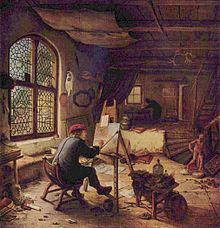
Jacob van Ruisdael: Windmill at Wijk bij Duurstede (c. 1670)

Haarlem, a small medieval Dutch city with more than seven and half centuries of history, can be found between Amsterdam and the sandy beaches of the North Sea. For most of its existence, Haarlem, like many similar municipalities scattered throughout the Netherlands, was a trading post for goods and services in its province. Haarlem was known for its textiles, spun with the assistance of strategically placed windmills along the Sparne river and the city’s canal system. Flowers, especially tulips and daffodils, and fresh fish, were also significant and eventually took over the textile markets. Both were traded in the main square and still are today. From the mid-16th-century, Haarlem started to flourish, and the Dutch Golden Age was just about to ignite, bringing wealth to all the local markets, including the art market. The first Dutch art museum opened in Haarlem after artists such as Frans Hals, Jacob van Ruisdael, and Adriaen van Ostade called the city their home. From then on, art flourished in the homes of wealthy merchants and spilled out in the streets, earning it the nickname ‘the city of the golden streets’.
For over 450 years a little glass and iron building called the Vishal has stood alongside the flower market and the north-east wall of the main square’s cathedral. Purposely erected in the shadow of the cathedral’s tall walls so as to shelter its contents during the day, the Vishal was Haarlem’s enclosed fish market, run exclusively by women. The fish was initially supplied by fisherwomen from Zandvoort, a tiny town on the North Sea about nine kilometres from Haarlem, and subsequently from other nearby areas. Almost daily until the middle of the 19th century, these brave women would walk from the windy seashores of the North Sea to Haarlem with buckets full of fish. They would cross the land over odd footpaths dug through the sand dunes and over the flower fields to trade their product.
About 30 years ago, the local diet, which had been based on fish, changed, and the demand for fish decreased, ultimately forcing the market to close. With financial help from the municipality, the Frans Hals Museum was able to step in and create a new vision: De Vishal (Fish Market). As well as the name, the museum preserves the structure, beams, and cobbled stone floor of the old market, together with all the marks and signs of its previous life, but with new glass and air-conditioning comparable to any high-end gallery. Since 1993 the Vishal has been known as an exhibition space for contemporary, modern art.

The Vishal Association is open (for a small fee) to every artist who lives in Haarlem, and is free to local art students. The space is open every day, special events are held just about every month, and the community of contributing professional artists has around 150 members and is always open to newcomers and ideas. The members organize about 10 free public exhibitions a year, and offer options to rent the space for private viewing and events. In recent years, under the direct supervision of Frans Hals museum director Ann Demeester, De Vishal has grown into a place where local art students can perform and display any type of art, including music, poetry, film, and theatre.
Ben Russo
Volume 34 no 3 January – February p 26
The Vishal Gallery, Haarlem, The Netherlands
https://www.devishal.nl/


Is the Netherlands once again gaining its place on the art roadmap internationally? If it’s in the New Art Examiner, it must be so. The Dutch mind has always interested me, as their perspective on just about anything is truly unique. What is going there today in the art world?